What is Kinedu?
Kinedu is a platform built to accompany you through your child’s development, from the moment they’re born until they turn six years old. It is a tool that allows you to give continuity to their learning process and the knowledge acquired at school and at home through:
- An adaptable curriculum with a personalized weekly plan.
- More than 2,000 activities and resources (videos, articles, songs, etc.) created by experts for each age and stage.
- Communication with your school through messages, a calendar, recommended activities, and metrics to illustrate your child’s progress.
- A family account that allows you to coordinate with family members and other people who have an active role in your child’s care.
- Tracking your child’s developmental progress through different milestones.
- Expert recommendations about the best products for your child’s developmental stage.
How does the interaction with my school work?
All the necessary interactions between families and the school can happen inside Kinedu.
The school has its own platform, in which they can track each student’s development to create a personalized plan that suits the child’s level and developmental needs.
Once you’re in Kinedu’s platform, you’ll be able to receive messages and announcements from your child’s school (see My Classroom section).
Through announcements and messages, educators will share your child’s progress with you, recommend activities, and inform you of important news and events.
Accessing Kinedu
Accepting your school’s invitation
Check your inbox for an email from Kinedu with your school’s invitation.
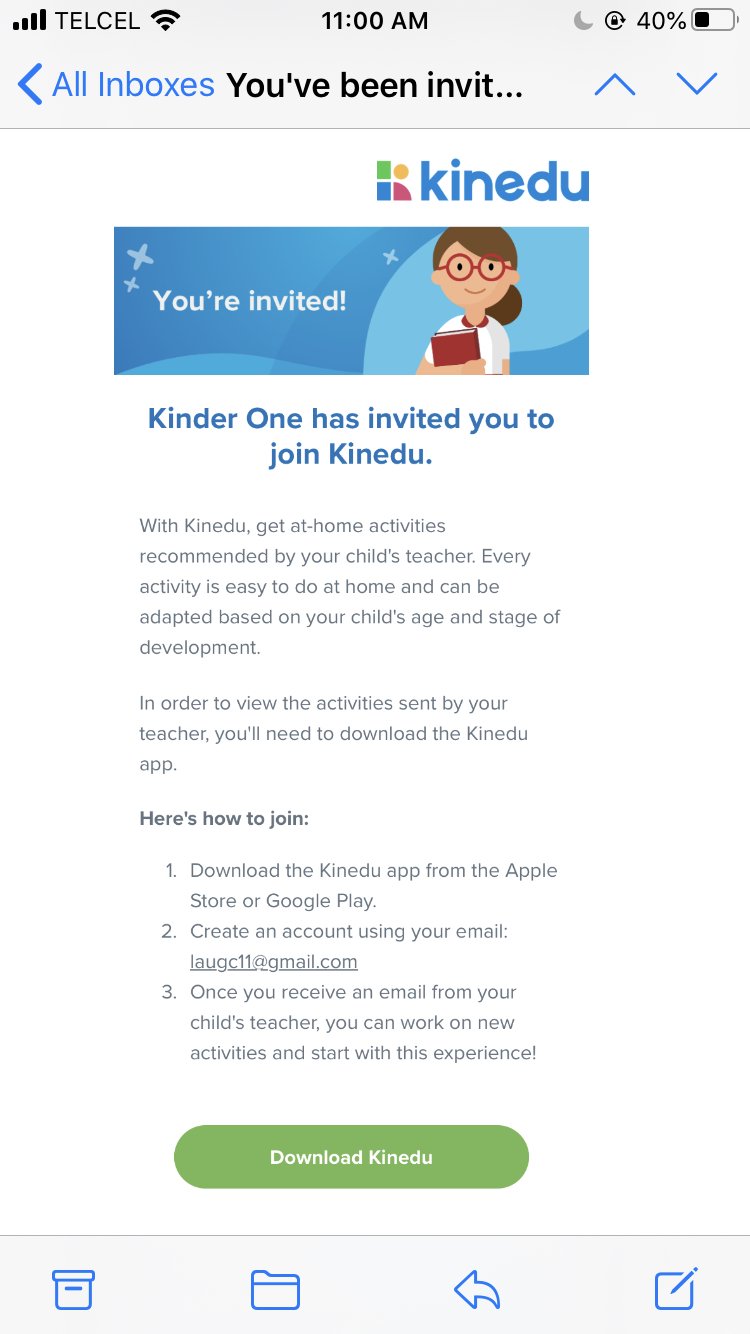
Click on “Download Kinedu”, which will send you to the Kinedu website (if you belong to the Semper Altius network, it will redirect you to this page). Follow the instructions to download the app.
*We recommend you follow these steps using your smartphone.
Downloading the Kinedu app
Once you click on “Download Kinedu”, you’ll be redirected to kinedu.com, or to the Apple Store/Google Play Store.
To download the app just click on the “Get” or “Install” button next to the image.
Note: The Kinedu app can only be downloaded on devices with IOS 11 or Android Lollipop.
What should I do if I can’t find the invitation from my school?
- Look for the invitation in your Spam folder
- Contact your child’s teacher so he/she can give you the classroom code (you’ll need to have a Kinedu account to enter the code).
What should I do if I don’t have a smartphone or my phone doesn’t have the necessary operating system?
Don’t worry! Kinedu is also available on your computer’s web browser. Click on the Web App option to head over to Kinedu’s website.
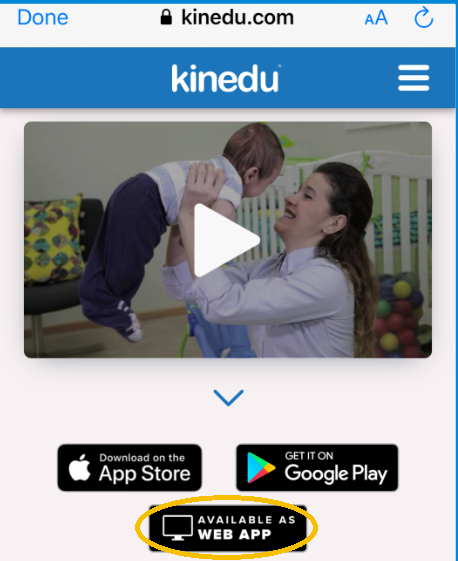
Create a profile
Open the Kinedu app, click on “Register”, and create an account and password.
Avoid using the functions for creating an account with Apple, Google, or Facebook.
Enter all your information: Name, last name, and family role (mother, father, grandparent, nanny, aunt, etc).
Once inside the app, go to the “My School” section, and enter the classroom code.
Initial assessment
Once inside Kinedu, the first step is to fill out an initial assessment about your child, based on different developmental milestones.
Click on “Start now”.
If you don’t have time right now, you can skip the assessment and come back to complete it later.
Tip: If you want to update the assessment, head to the “Progress” section, and click on “Indicators”. Afterward, click on the “Update assessment” button in the upper right corner.
Why is the assessment important?
Each child’s development is unique. This assessment allows us to understand the stage your child is in, including the developmental milestones that they have reached, and the ones they’re still working on. This will help us suggest personalized activities for you and your child’s teachers to support their optimal development.
Developmental milestones
Your child’s development will be measured through the milestones of four key areas: physical, cognitive, linguistic, and social and emotional.
Some examples of the skills measured in each area are:
- Physical: walking, jumping, hand coordination
- Cognitive: imagination, memory, learning concepts
- Linguistic: sounds, words, language comprehension
- Social and emotional: social relationships, self-care, emotional intelligence
Before starting, remember that each baby follows their own path and rhythm. Because development can happen in many different ways, we present you with a wide range of milestones for each ability. Don’t worry if your child hasn’t reached some of them yet.
When should you mark a milestone as completed?
If your child can constantly do the action that the milestone describes, you can mark it as completed.
Note: For more information about milestones, you can go to the “Progress” section.
My plan
Your activity plan is a program designed specifically for your child. To create an activity plan, Kinedu uses the initial assessment you completed when you registered.
This activity plan is generated for a period of seven days, and when it ends, Kinedu analyzes the missing or completed milestones and generates a new plan.
Remember that this plan is generated by Kinedu, not by your school.
Mi Activity Plan (School)
You’ll be able to see the daily activity plan that your child’s teacher planned, and any changes made to the plan will be updated automatically.
You can see past or future activity plans just by clicking on the arrows at the top of the screen to change the date.
This new display will help you see important information in an easier and faster way, since it has quick access to publications, chats and materials.
You will still have access to the Kinedu catalog, where you can find personalized activities, tailored to your little one’s development.
Kinedu-recommended activities
Your plan will include many types of activities; some of them will be easy for your child, while others might be more challenging, but these activities can be adapted to make them a bit easier. The more challenging activities are designed to foster the development of the proximal zone.
Don’t expect your child to complete all the activities on the first try; they’re designed to be completed gradually as time goes by. The most important thing is that your child practices constantly to strengthen their skills.
Kinedu-recommended articles
Besides activities, your plan will also include some relevant articles for you and your child. These articles are written by specialists in early childhood development and education, and contain information about many different subjects, like health and nutrition.
Registering advances
When marking an activity as completed, you’ll be asked to fill out a short assessment. There, you’ll have to answer if your child achieved certain milestones related to the activity.
It’s important to answer the assessment questions, since this is how the milestones are updated so the activity plan can be adjusted according to your child’s specific needs.
What happens if my child didn’t reach any milestones after doing the activity?
Don’t worry! It’s completely normal if your child hasn’t reached some milestones yet. Just mark the “Not yet“ option, so we can include more activities that will help them develop these skills, and little by little, they will reach them. You should only mark a milestone as “Completed” if your child can do the skill repeatedly and consistently.
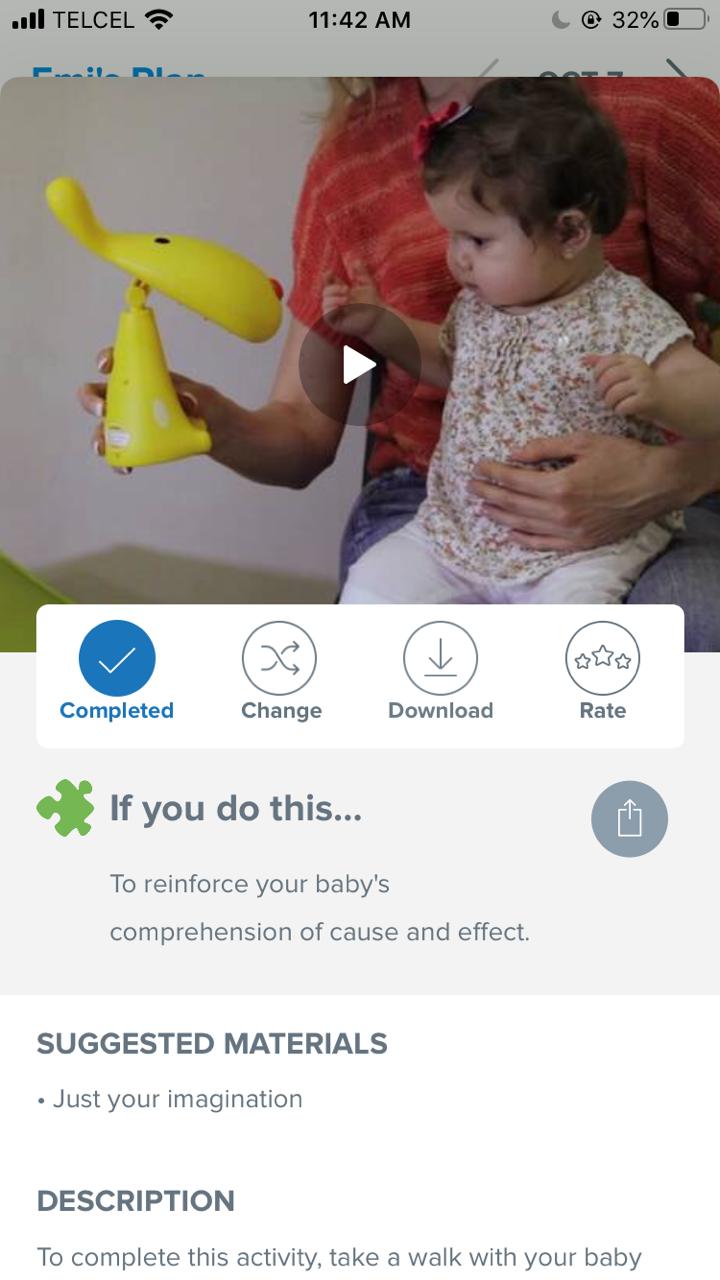
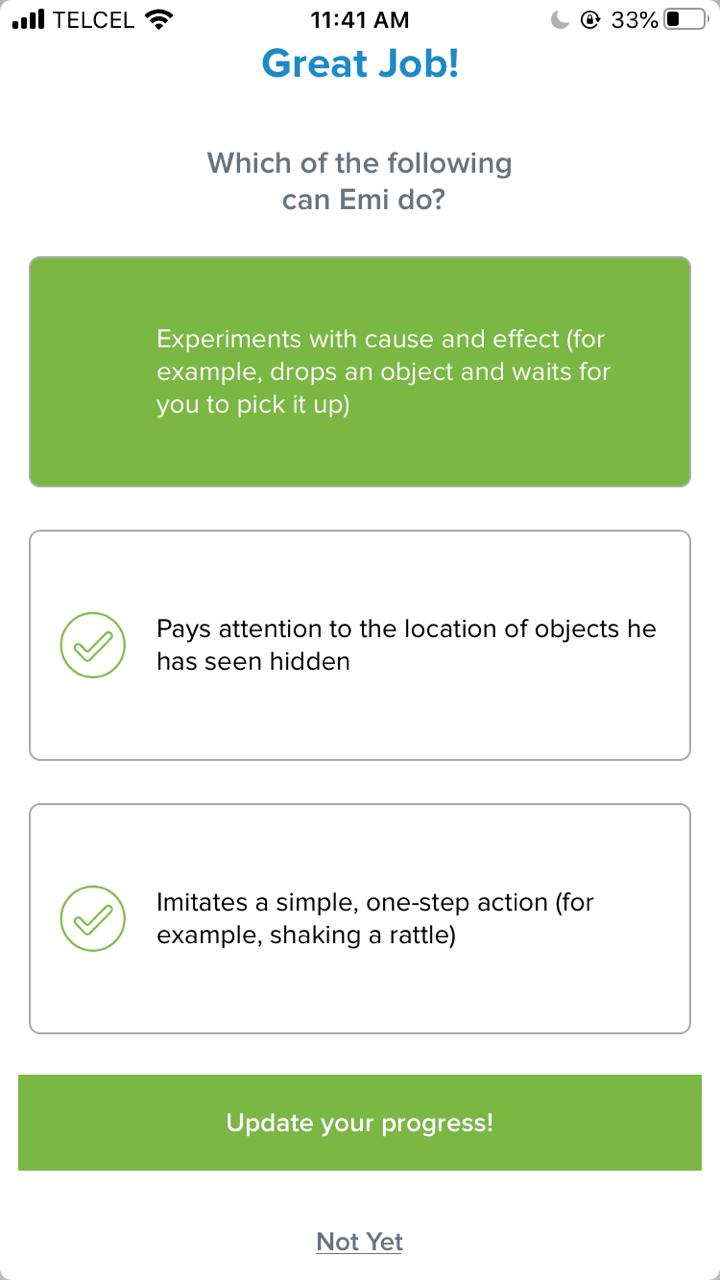
Downloading an activity
Note: Currently, this function is only available for iOS.
We know that you might want to access an activity when there’s no internet available. Kinedu allows you to download activities so you can see them even if there’s no network nearby.
To download an activity, click on the “Download”. Wait a few seconds while the video is downloading and you’re all set! You’ll be able to see this video anytime you want, even when there’s no internet connection.
To see all your downloads head to Catalog > See all collections > My downloads.
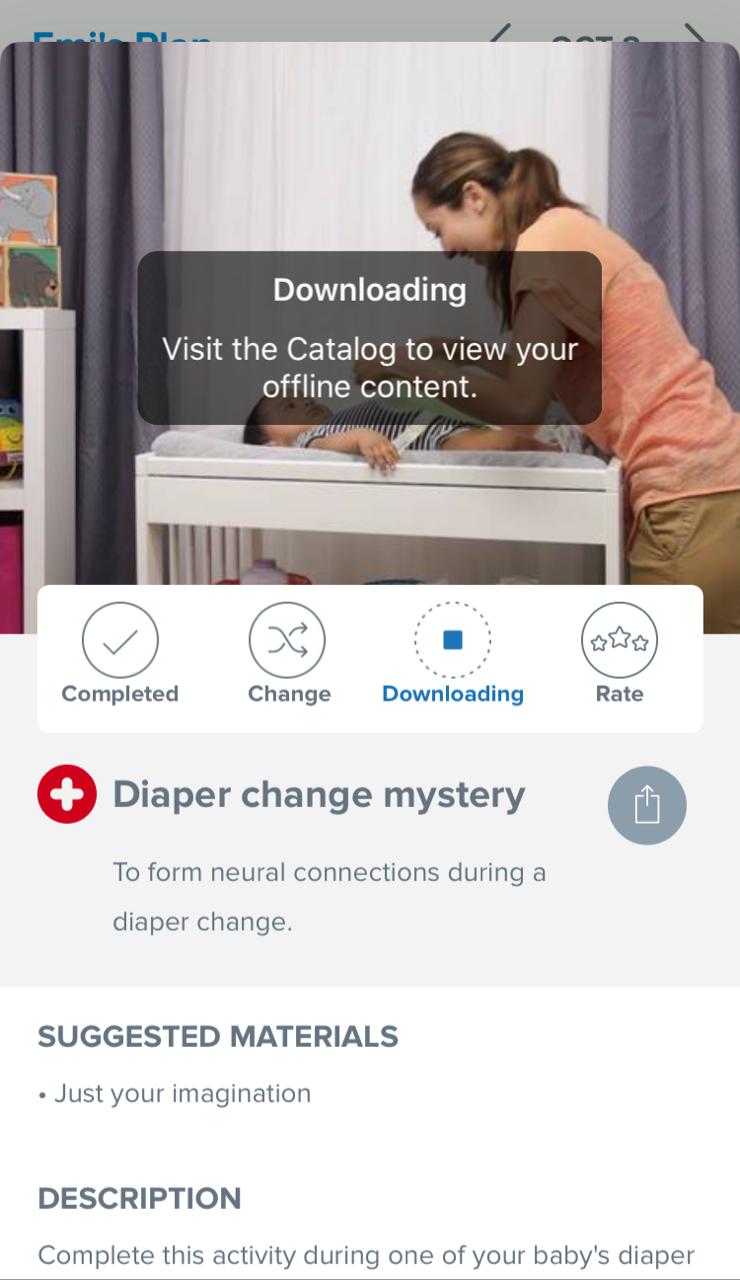
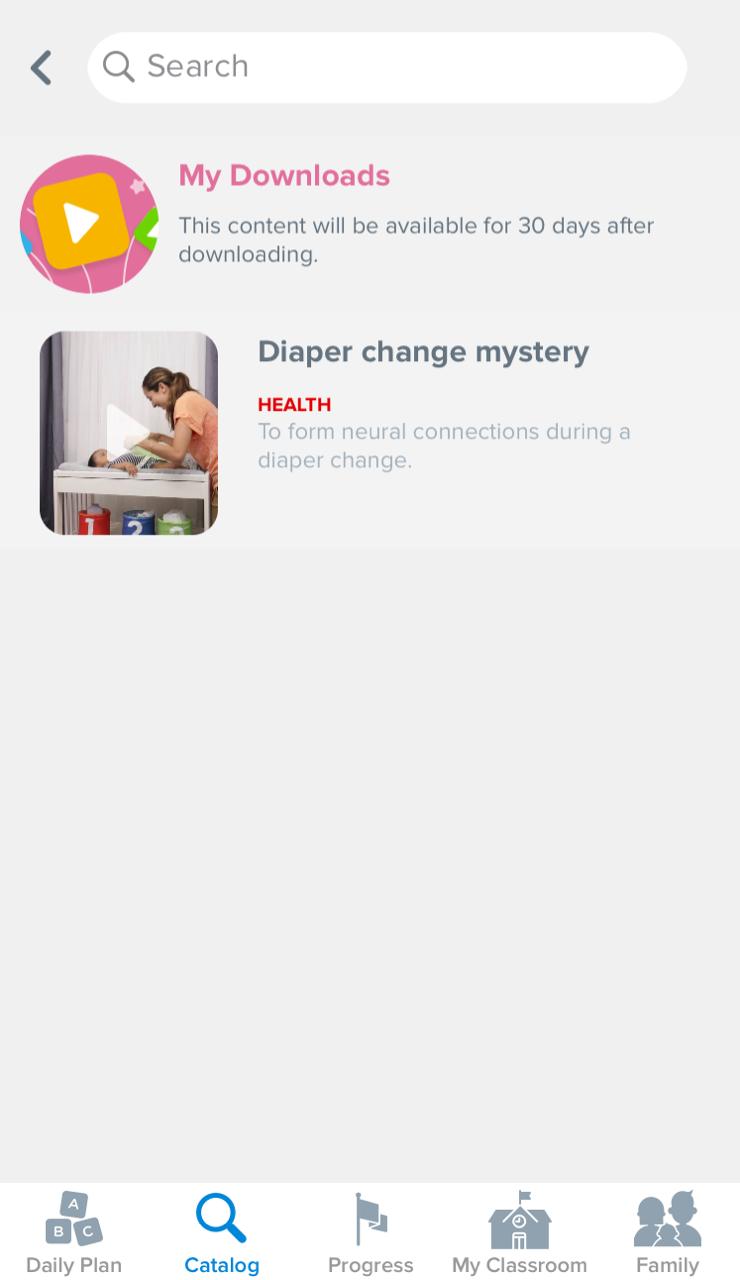
Changing an activity
Sometimes we might suggest an activity that you don’t like or can’t do at that precise moment. This is why you have the option of changing activities whenever you like.
You just have to click on “Change” and tell us what kind of activity you’d like to see instead. You can choose:
- An easier activity
- A harder activity
- Different materials
- No materials
- Same development area
- Surprise me!
We will show you some alternative activities and you can click on whichever suits your needs!
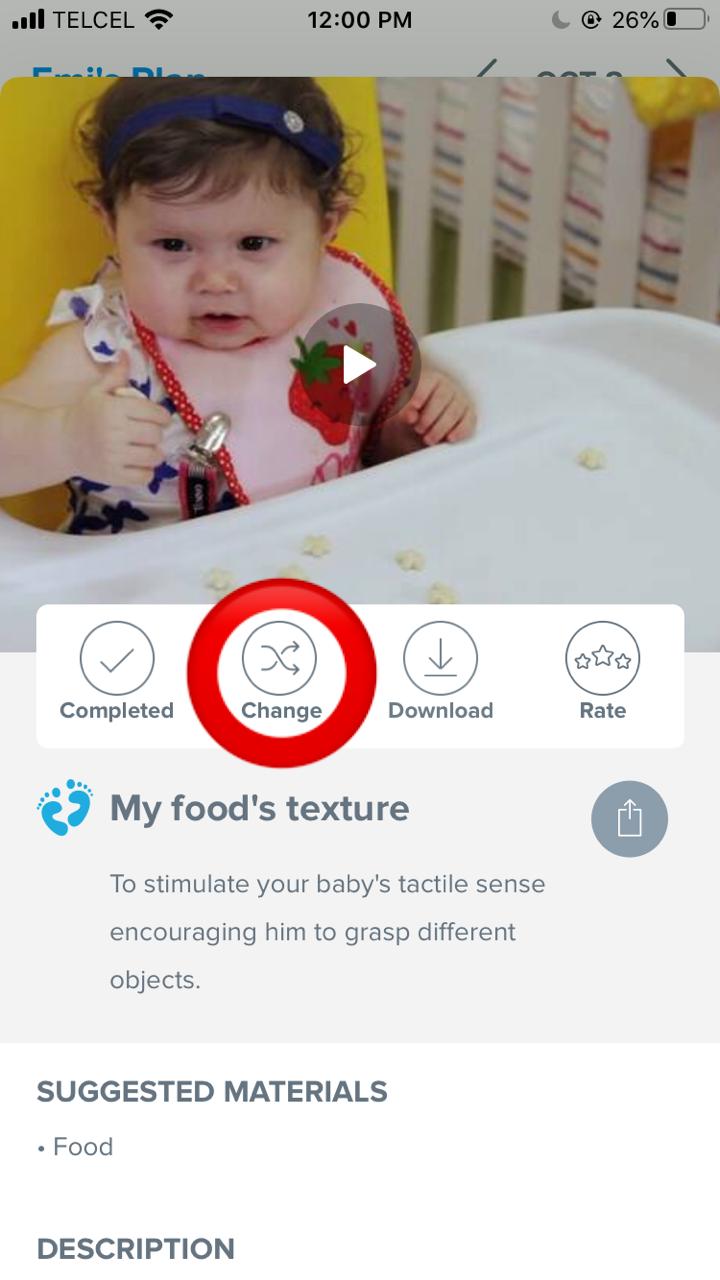

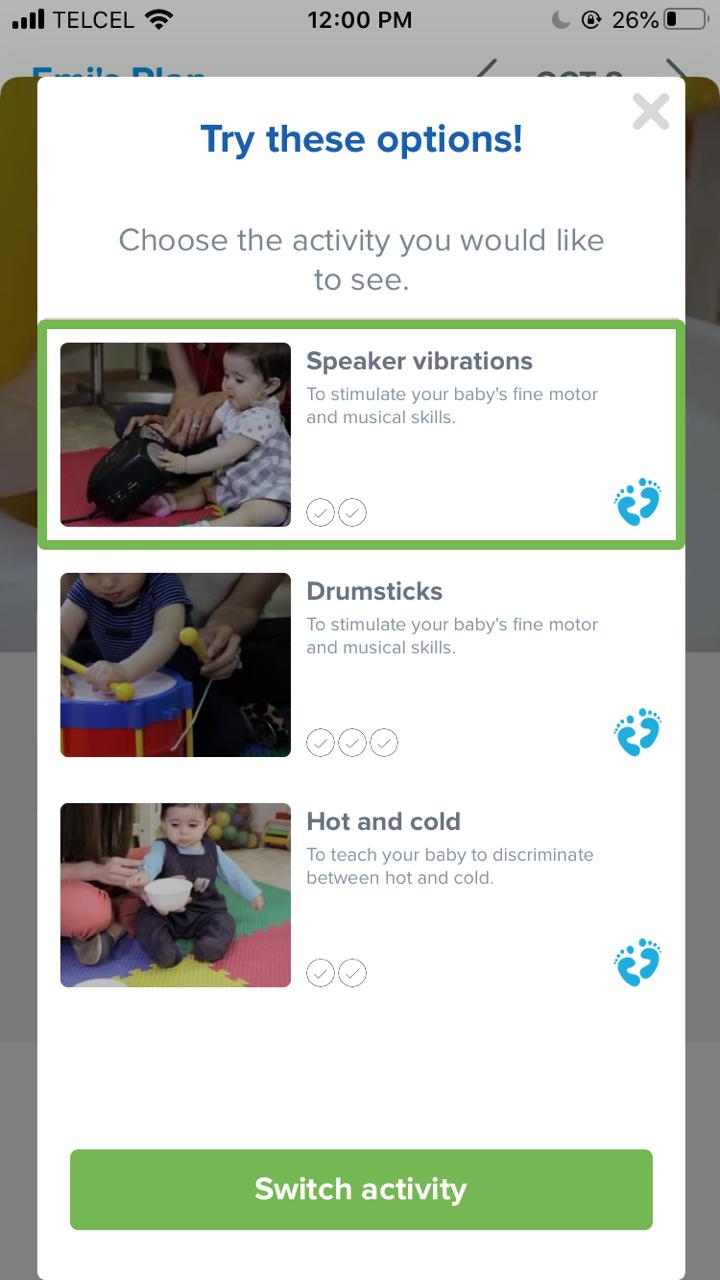
Sharing an activity
If you want to share an activity with one of your friends or publish it on social media, click on the share icon that appears next to the name of the activity.
After clicking the share button, you’ll be able to choose where you want to share the activity. You can share it through a message, Whatsapp, email, and social media.
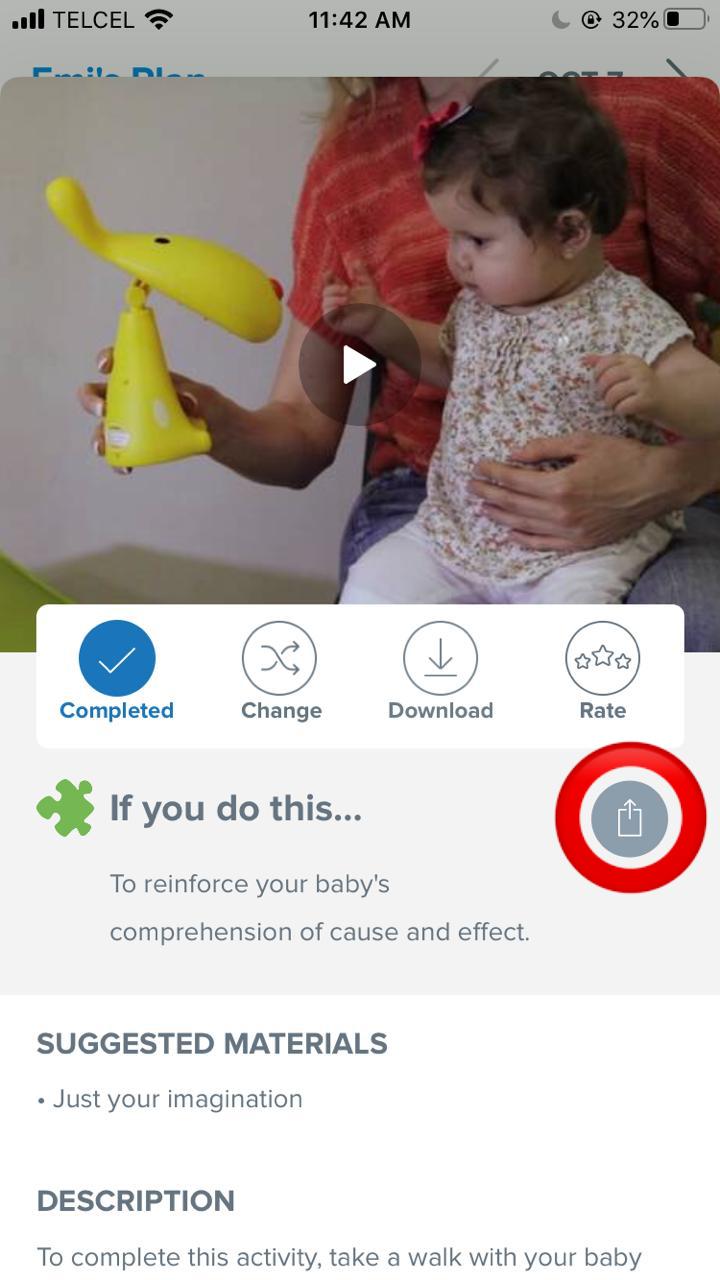
What do my contacts receive when I share an activity?
When you share an activity with your contacts or on social media, you’re sharing a link to the activity. Below, you can see an example of what your contact will receive.
If your contact has the Kinedu app, the link will take them straight to the app. If your contact doesn’t have the app, they will be redirected to the Kinedu website.
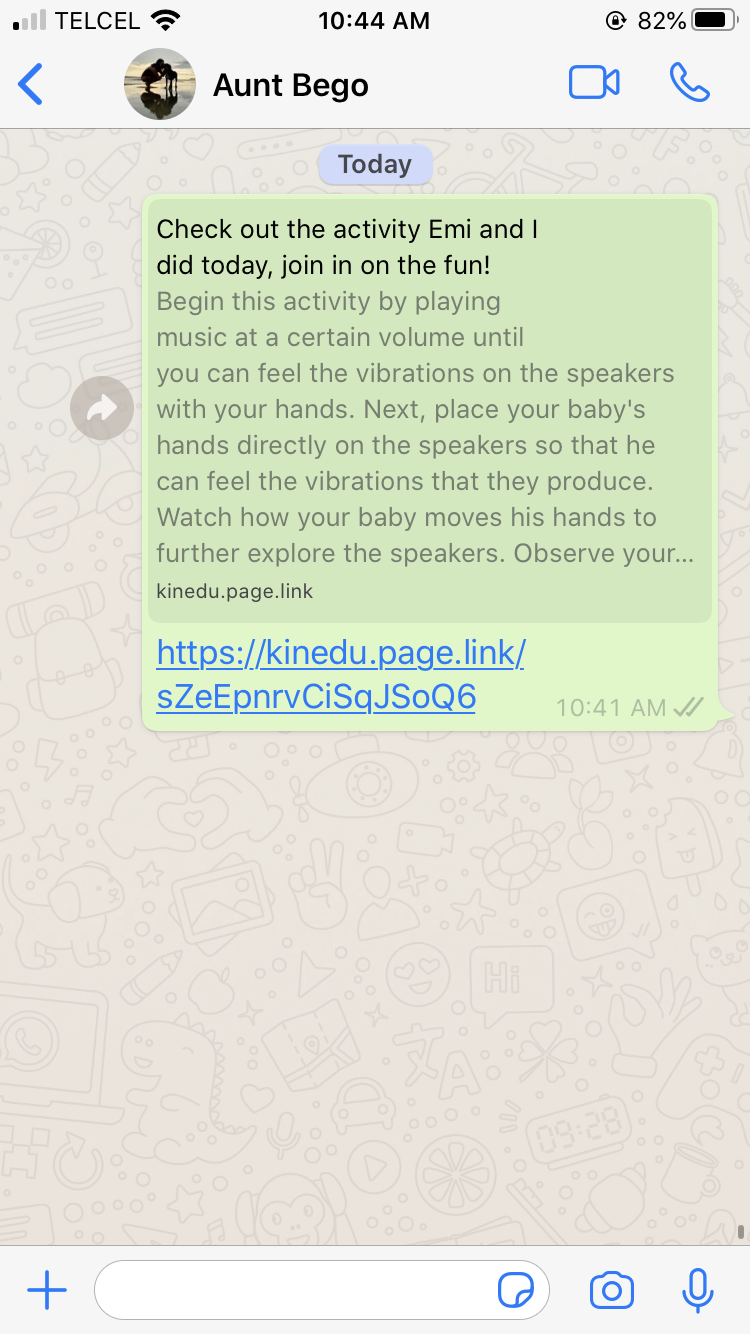
Leaving a comment on an activity
You can leave a comment on any activity that you see or do. This comment will be sent to Kinedu (not to your school) and it will be visible for the entire Kinedu community.
Through the comments, you can ask questions, share advice, or simply tell us about your experience with the activity. Your questions will be answered by Kinedu’s team of experts in early childhood and development.
My school
“My school” is the section in Kinedu where you’ll interact with your child’s school. Your school will be organized into three categories: feed, chat, and calendar.
Feed
On the “Feed” section you’ll receive all school’s notices and updates about your child.

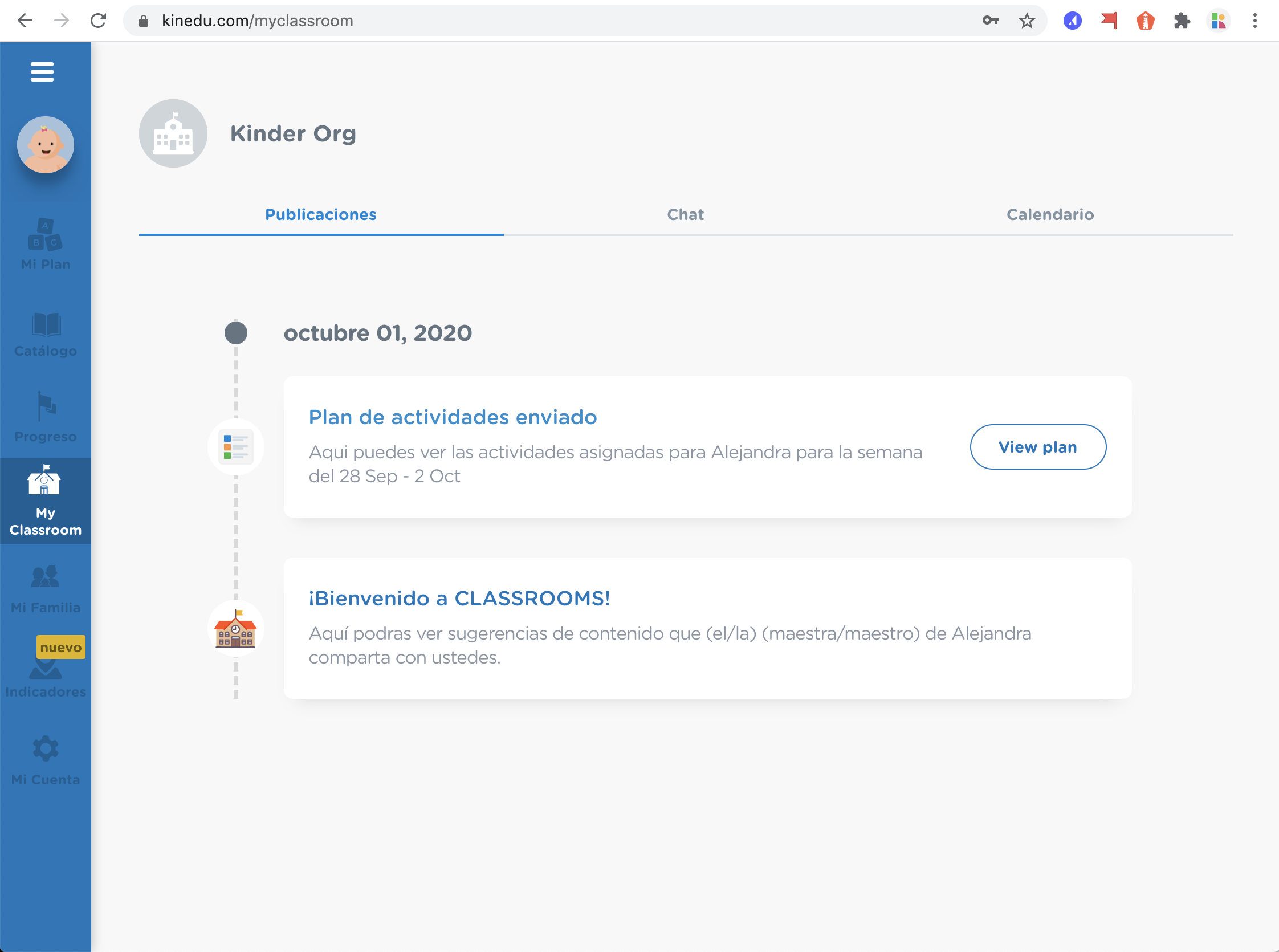
Types of notices and updates
Assigned activity: Your school can suggest activities for you to do at home. To open the activity, click on “See activity” and we will take you straight to it.

Completed activity: Every time your child completes an activity at school, you’ll get a notification. To see the activity, click on “See activity” and we will take you to it.
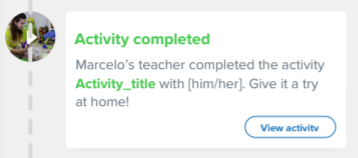
Milestone achieved: Every time your child achieves a new milestone at school, you’ll receive a notification. If you want to find out more about your child’s progress with this milestone, click on “Learn more”.

Kinedu article: Your school can share articles that they think you might find interesting, or that are relevant to your child’s development. To read the article, just click on “Read article”.

Documents, images, and links: Your school can share all kinds of files with you, like images, documents, and links. To access these files, just click on “View file”.

Lesson plan: Your school can share the lesson plan your child will be following during the week. You can access the plan from your feed or from your email.

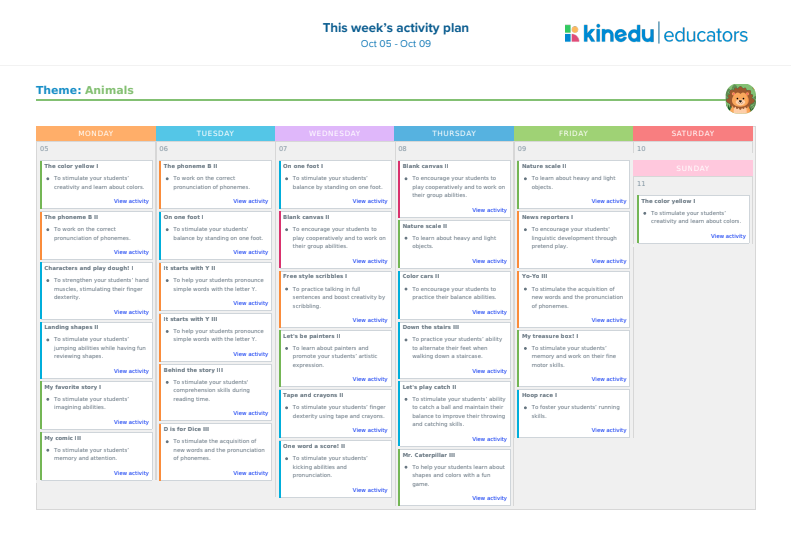
Evidence
Now you will be able to send teachers evidence of your child ‘s progress in a quick and easy way from the “My School” section.
- Go to the Feed section and click the green (+ Evidence) button on the upper right corner
- Choose if the evidence is an image or another type of file
- Select the image, video, or file
- Done! Your evidence will be sent to your child’s teacher
Chat
The chat section is where you can send and receive messages to and from your school.
You might get two types of messages: announcements and personal messages.
- The announcements are sent to the whole school, to a classroom, or to a group of students.
- The messages are private and are only sent to your family.
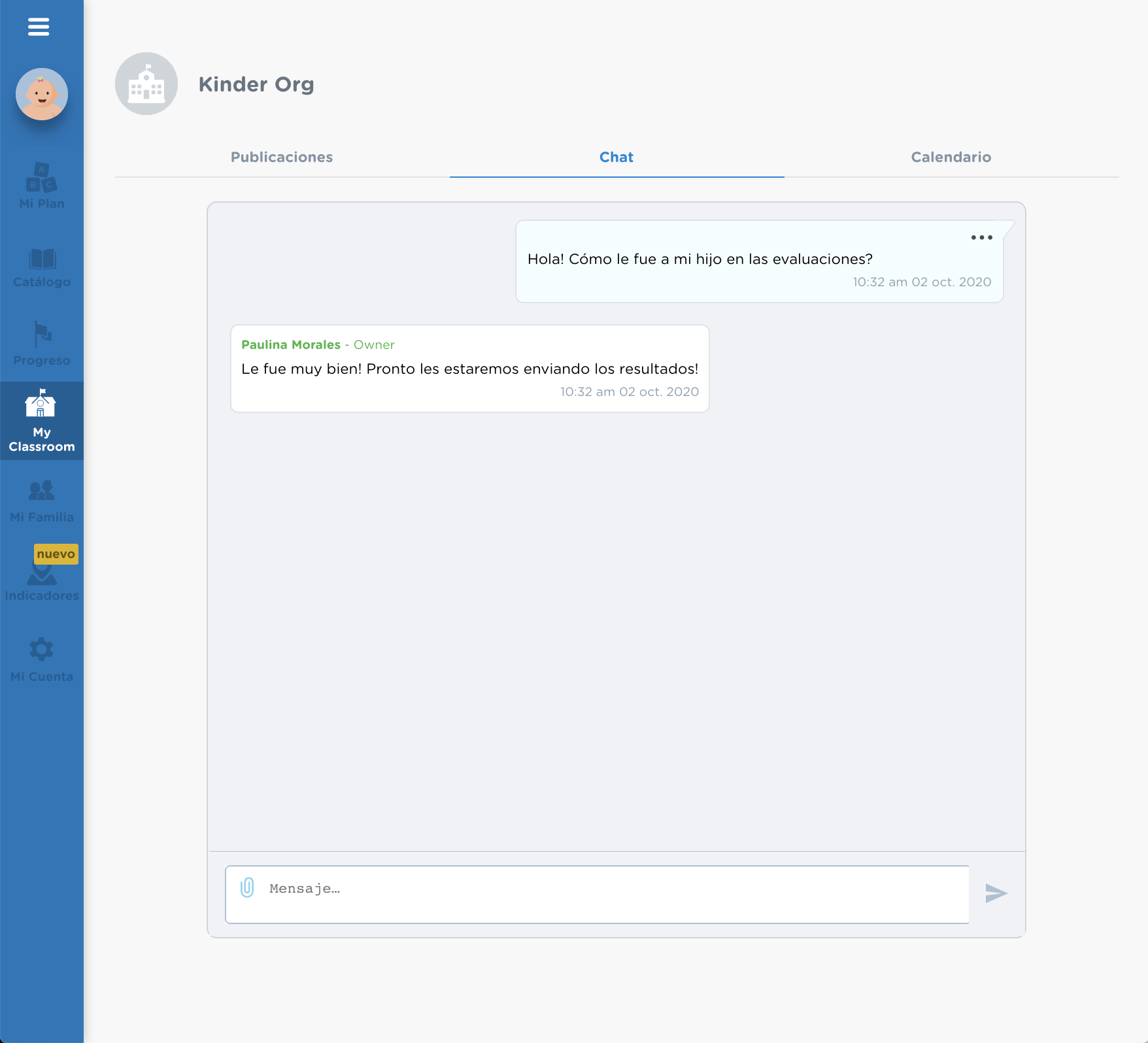

Sending a message to your school
To send a message to your school just head to the chat section, write your message in the box at the bottom of the page, and click the send button on the right.
This message will be sent to your child’s teacher, the school’s director, and the administrator. Currently, there isn’t a function to send a private message to a specific person.

Answering a message
To answer a message, you just have to click on the message and write your answer in the box at the bottom of the page. You can also attach files, like images, PDFs, documents, etc.
How can I delete a message?
To delete a message, click on it for a couple seconds and then click on the trashcan icon.
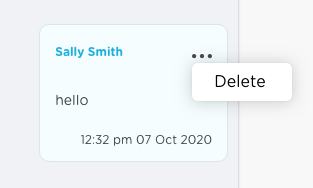
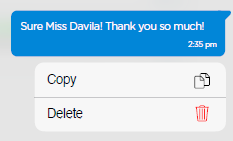
What should I do if my message wasn’t sent?
If your message wasn’t sent, you’ll see a red icon next to it, indicating that it hasn’t been sent. Click on the message to resend it.

If after trying again you still can’t send it, check that your internet connection is stable. The most common reason for not being able to send or receive messages is a poor internet connection.
Forums
On the Chat section of the Kinedu app, you’ll be able to see the forums you’ve been added to by members of your school, or the forums you’ve joined through the app.
If you click on the “All forums ” button, you’ll be able to see all the available forums that your whole family can join. These forums are created by your school.
Below your individual conversations, you’ll be able to access the forums you’ve been added to, or the ones you’ve joined.
By entering a forum you’ll be able to see the messages and the members in each of the chats.
You will also have the option to answer a particular message, or report a message that might be inappropriate. Group moderators will monitor the group and evaluate each message.
Through these forums you’ll be able to communicate with teachers and other parents from your school
Calendar
In this section you’ll be able to see your child’s school calendar.

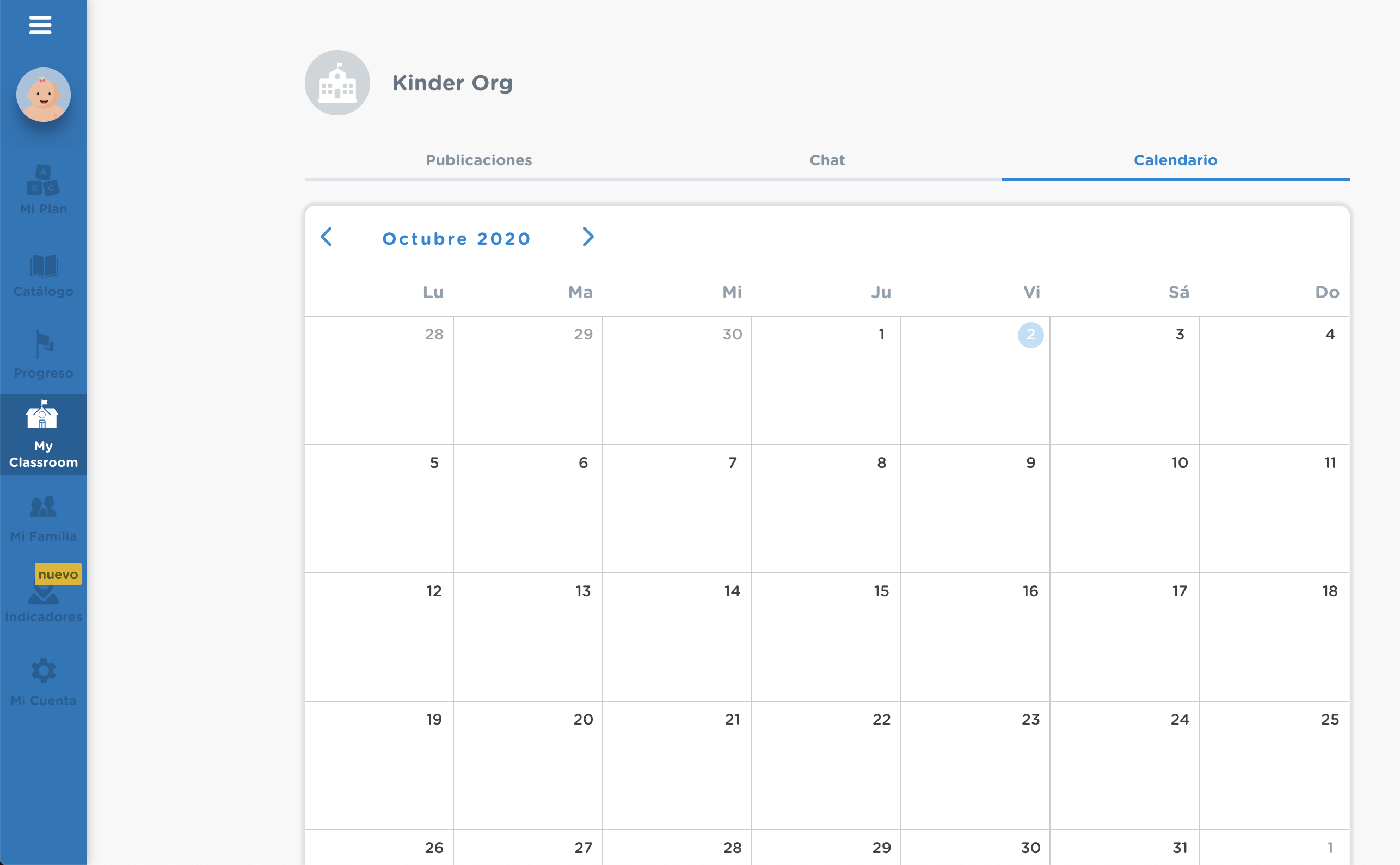
Seeing the daily events
Any day that has a dot underneath the number is a day with at least one scheduled event.
To see a day’s events, click on the day you wish to see, and the list of events will be shown underneath.
To see the details of an event, click on the event and you’ll be able to see the description of the event, the time, and the location where it will take place.
Some events might include links to a videoconference. To access them, just click on the event and then on the link to the conference.

Progress
“Progress” is the section in Kinedu where you can see how your child’s development has progressed, and where you can update developmental milestones.
This section is divided into two sections: Milestones and Progress
Milestones
On the “Milestones” tab, you can update your child’s progress, marking the developmental milestones they have completed.
To update a milestone, go to the development area and select the skill you’d like to update. When you click on a milestone, a questionnaire will pop up. Click on the “Mark as completed” if your child has reached the milestone.
Tip: Click on the upper right section where it says “Update assessment” to update the initial assessment and see a general view of the milestones.
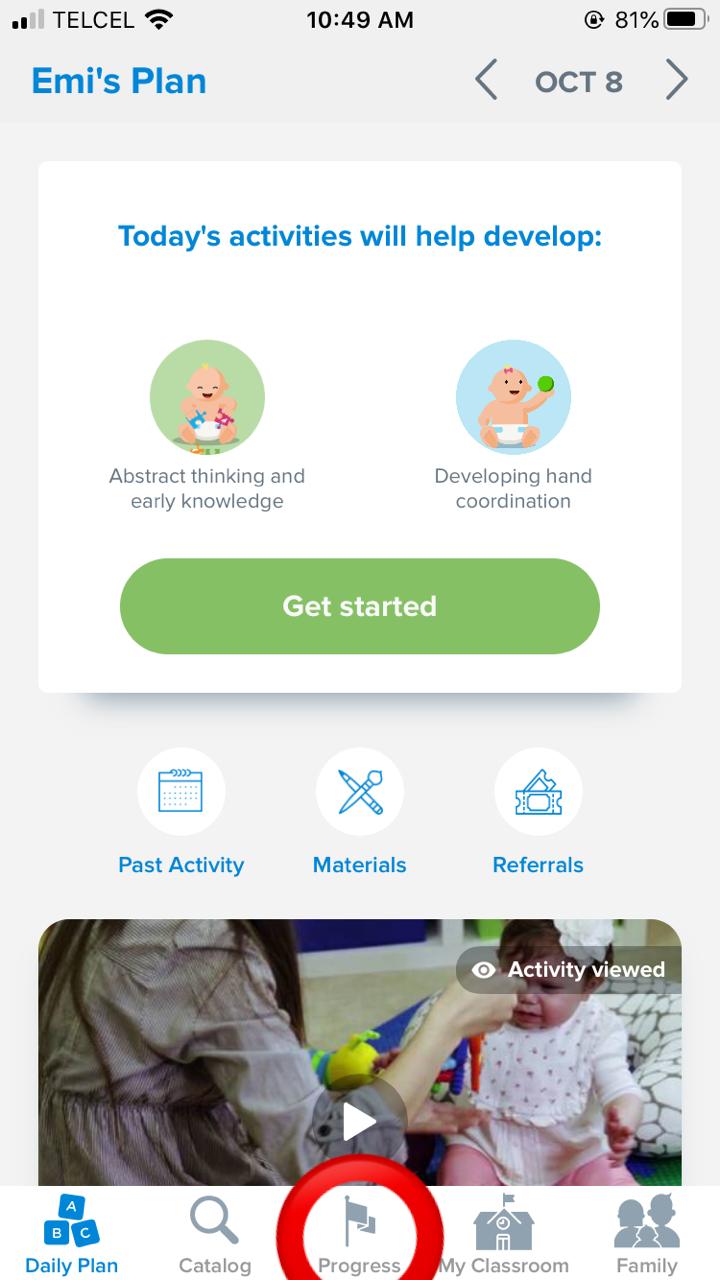
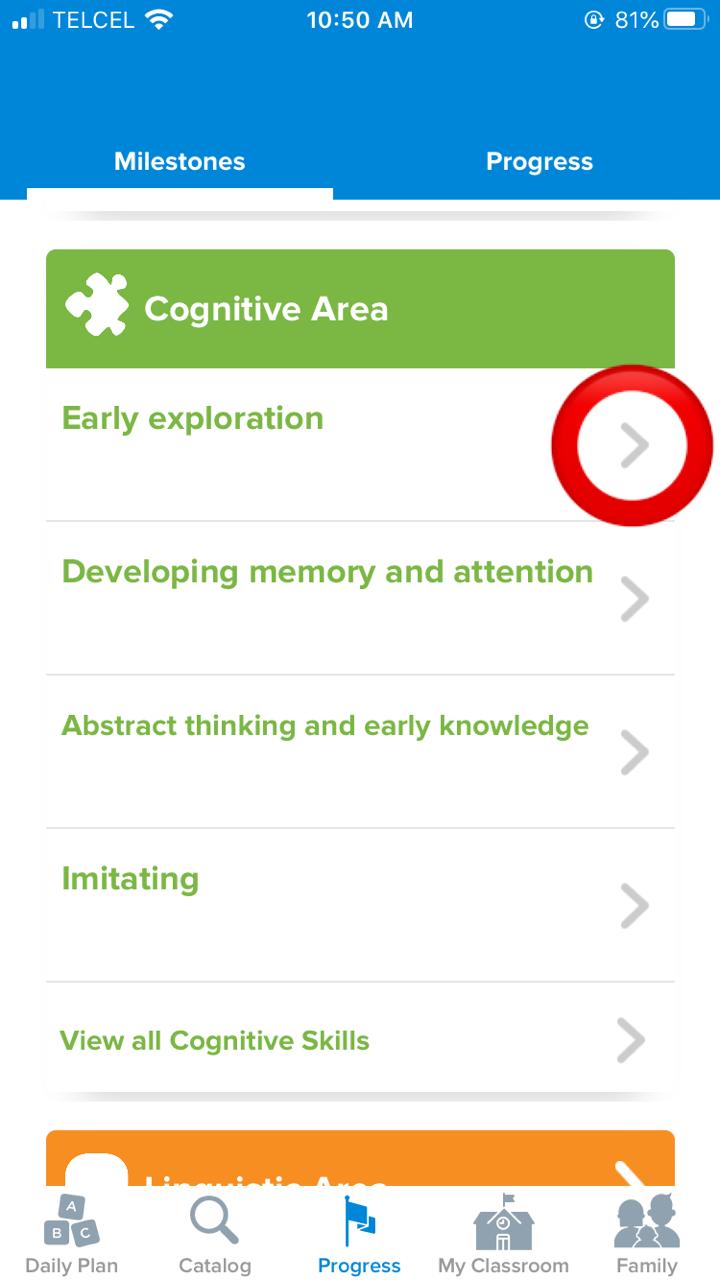

If your child has mastered a skill, click on the button that appears on the center part of the skill. We will ask you a couple of questions so you can make sure the skill is mastered.

Progress
In this section, you’ll be able to see your child’s progress and compare it with reference points for children of the same age.
This section, just like the “Activities” section, is divided into four areas of development: Physical, Linguistic, Cognitive, and Social and Emotional.
The initial assessment and the progress reports done after performing activities at school and at home allow us to map out your child’s progress.
By clicking on one of the development areas, you’ll see the progress in each skill related to that area. You can click on any of these skills to see more detailed information about your little one’s development.
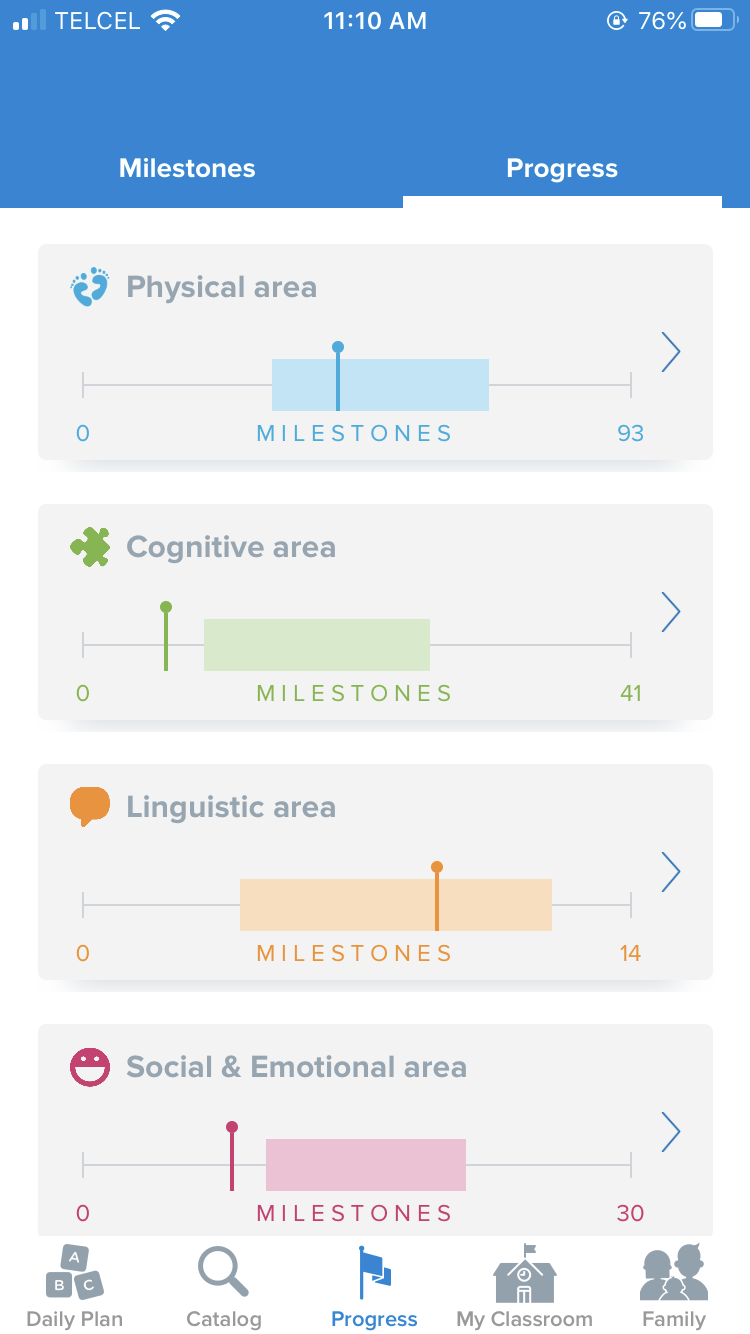
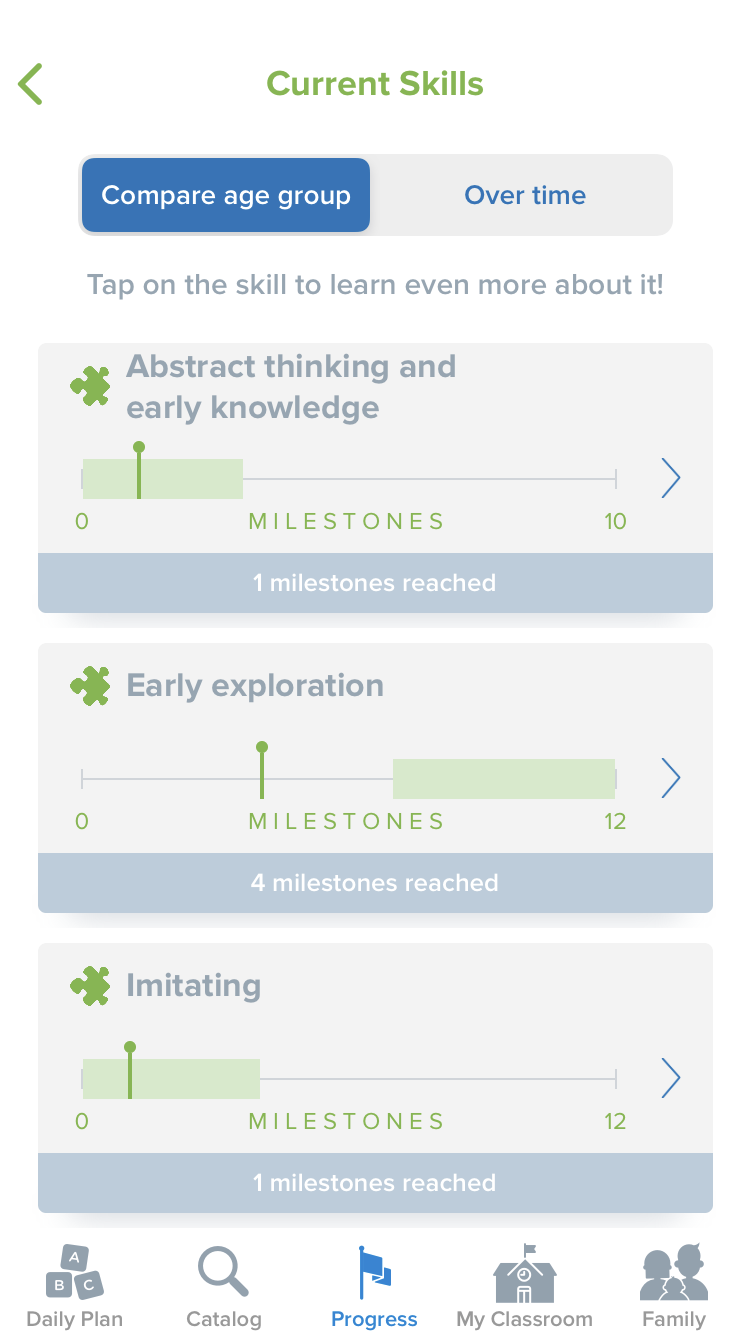

How do I read the development graphs?
- The pin marks your child’s progress
- The bar represents the 10-90 percentile range of children the same age as your kid
If your child (the pin) is within this bar, it means they are inside the normal range of kids that age.
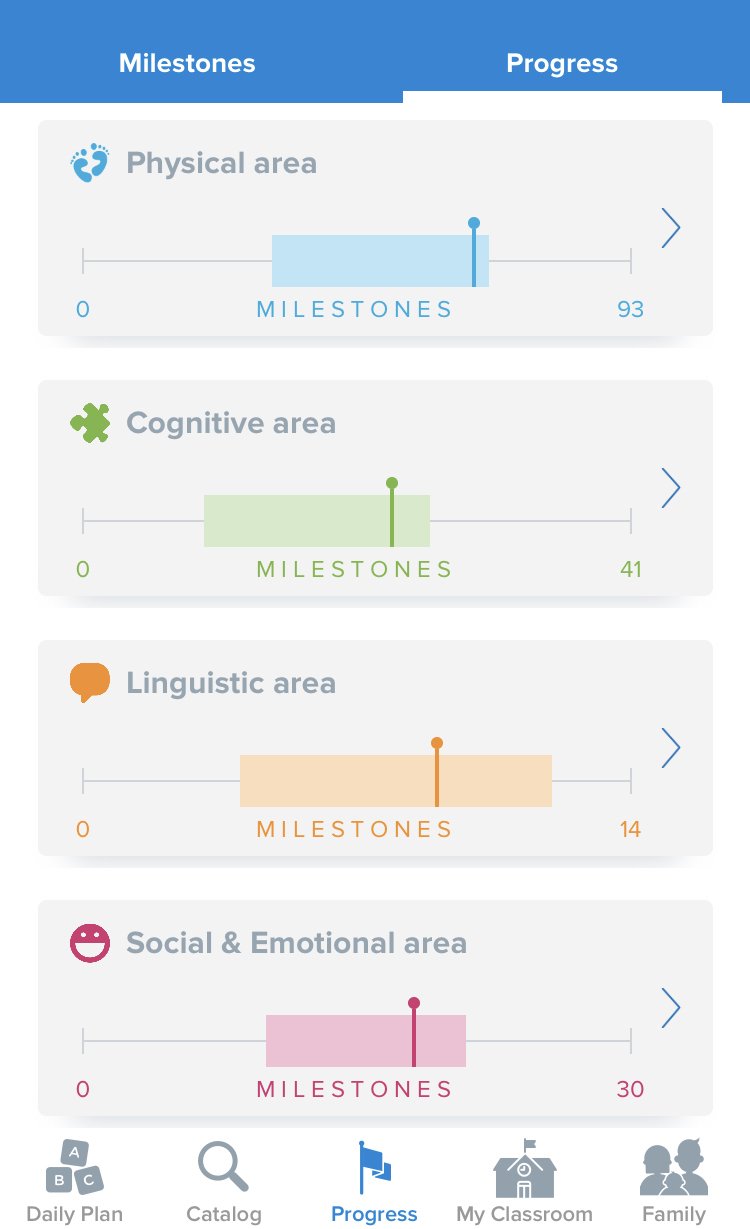
* The image above shows an example in which the physical area has 93 milestones, the cognitive area has 41, the linguistic area has 14, and the social and emotional area has 30. These indicators change automatically according to the age and development of your child. The child in this example is within the normal range since the pin is inside the bar in every area.
How are your child’s results calculated?
Your child’s results are determined using guidelines from the American Academy of Pediatrics (AAP) and the World Health Organization (WHO), as well as the answers from millions of Kinedu users, which have helped us further confirm the validity of our milestones with their answers.
We understand the role that variability plays in childhood development, and this is why we focus our results on percentiles per skill. These percentiles help us better understand your child’s progress in comparison to other children of the same age.
Skills by age and through time
Note: Currently this function is only available for iOS.
In the “Progress” section, you can see your child’s progress through time, and in comparison to other children of the same age.
Just click on the area you want to see and move the switch from “Compared by age” to “Through time”, and vice versa.
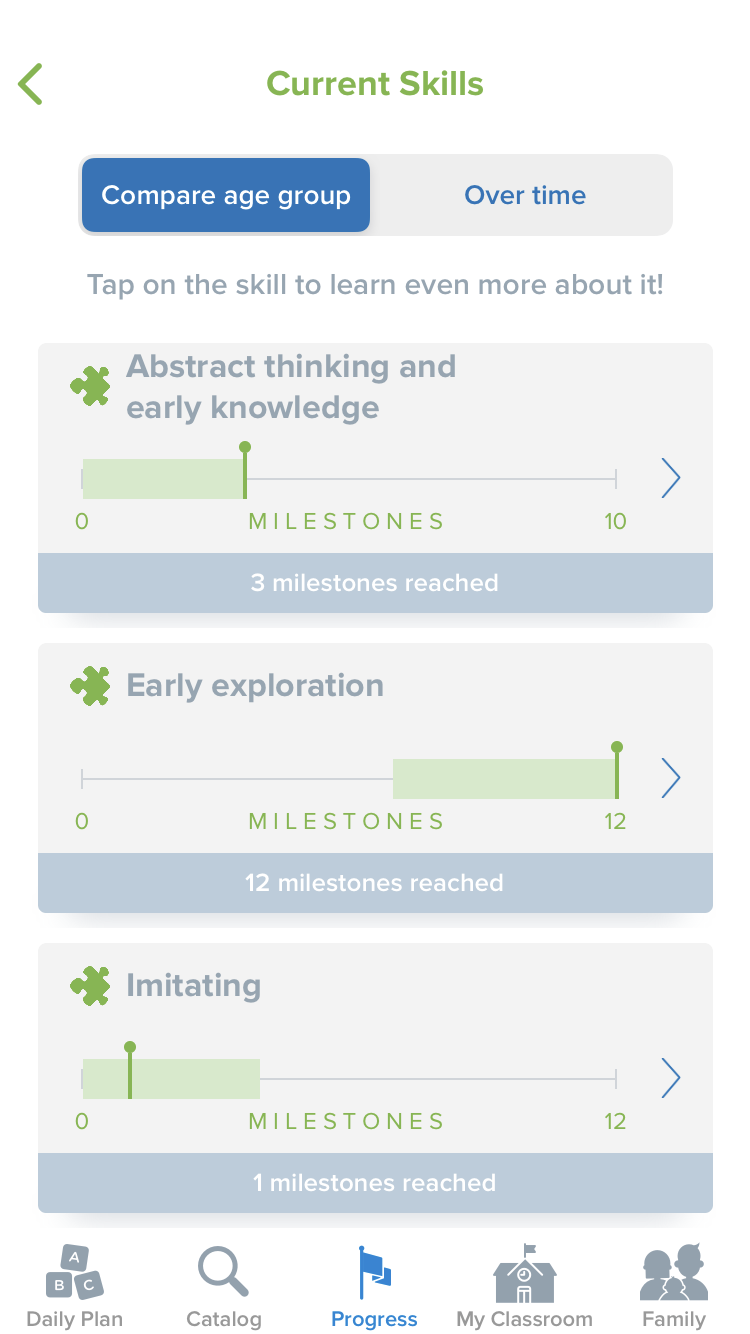

Click on a skill to learn more about it and explore activities and articles related to this skill.
Percentiles
To see the percentile of a skill that your child has developed, go to:
Progress > Progress > click on the development area you wish to see > click on the skill you wish to see.
By choosing a skill, you’ll see a page with details about it and the percentile your child is at with this particular skill.
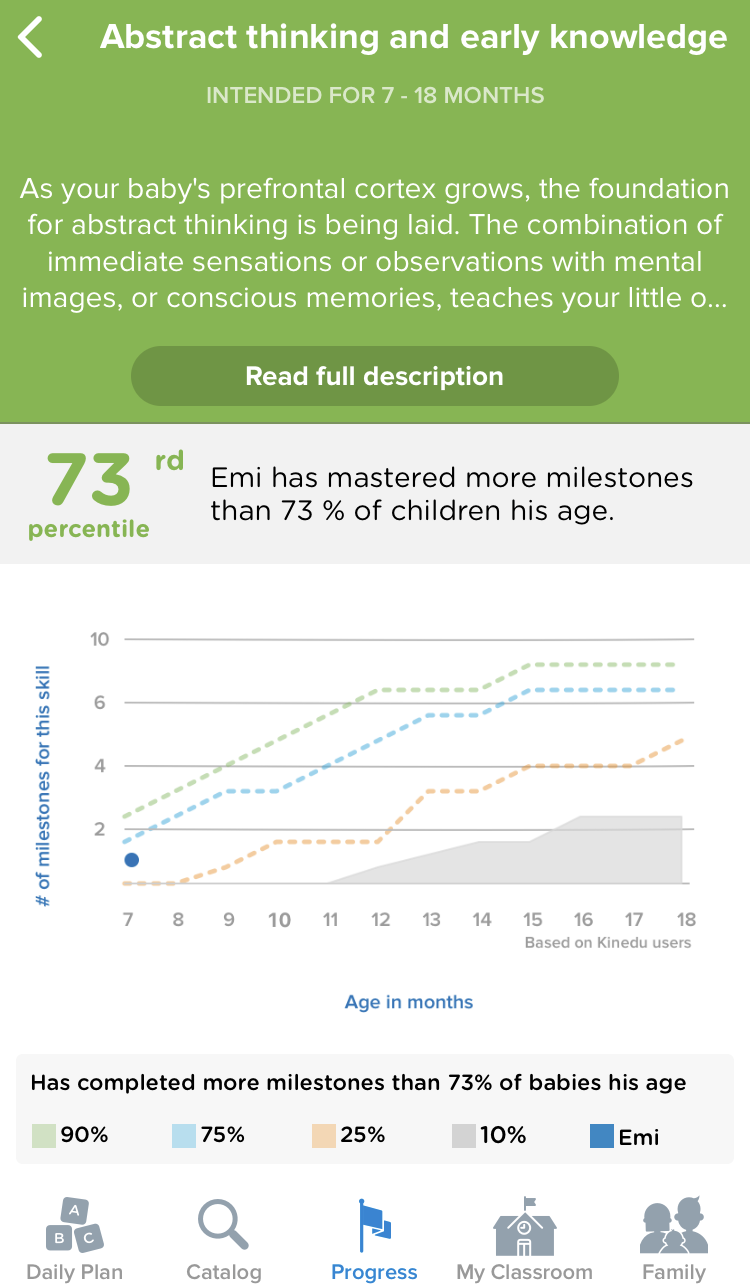
What do my child’s percentiles mean?
The percentile represents your child’s position according to their results, compared to the results of other children of the same age.
For example, if your child is at 55% it means that their results are higher than 55% and lower than 45% (100%-55%) of other children of the same age.
What does it mean if my child has a low percentile?
Usually, this isn’t a cause for concern. A low percentile is not a red flag. Each child is unique and learns at their own pace. We will be paying special attention to the skills with lower scores, and we will recommend activities that focus on practicing and strengthening these skills.
If you have any further questions or concerns, contact your pediatrician and ask for their opinion.
Progress graphs
You will find a graph on the percentile page. The graph’s horizontal axis, or “X”, represents the age in months, and the vertical axis, or “Y”, is the number of milestones for each skill. This graph can be read as if it was a size and weight graph.
The graph has three dotted lines, the green one represents the 90 percentile, the blue represents 75, and the orange represents 25. The gray shaded area represents the 10 percentile. The blue dot marks the spot your child is at.
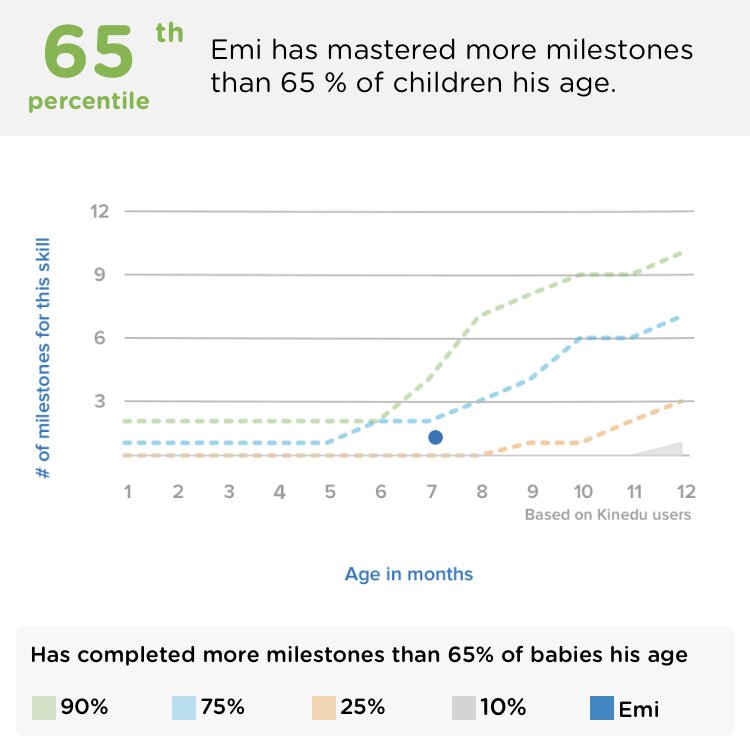
* The image above represents a skill with 12 milestones and a child that is 7 months old. The child has a percentile of 65, which means he has completed more indicators than 65% of children of the same age. The graph shows that 25% of the children reach about 7 milestones in this skill by the time they’re 12 months old (the blue dotted line -75 percent- raises to 7 at 12 months).
To see the milestones within each skill, click on the doctor below the graph.
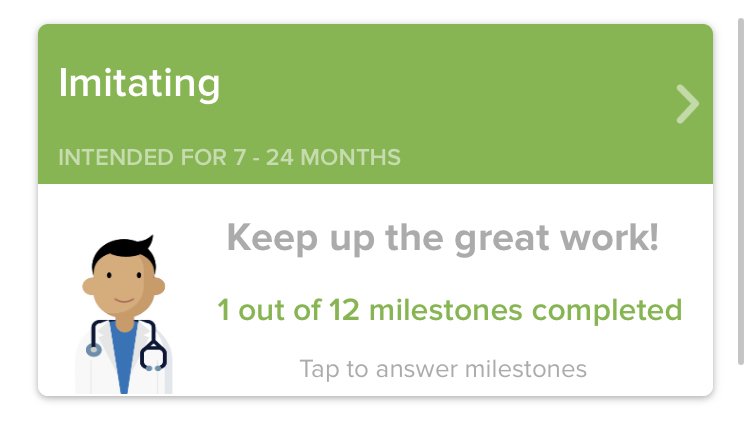
Catalog
In the “Catalog” section you’ll have access to a great collection of activities and articles, and you’ll be able to filter and search activities according to your needs and interests.
Collections
Once in the “Catalog” section, you’ll find many collections and different subjects created by experts thinking of your child’s needs according to their age and developmental stage.
In each collection, you’ll be able to find activities and articles related to specific topics and stages of development.
The “Catalog” section is divided into three sections:
1 . Recommended for Your Baby
This section is designed specifically to suit your baby’s skills and developmental needs. In each collection you’ll find activities and articles related to the theme and to your child’s developmental stage. These collections and their respective activities change every month so you can have new and updated content.
2. Kinedu Learn, Expert-led classes (This section is exclusively for Kinedu Learn members)
Now you teachers will be able to share collections with you. In this section you will find collections shared exclusively by your teachers to provide your child with a more complete educational experience.
3. All collections
Here you will find all the collections and activities offered by Kinedu. You can filter them by age to find the activities that will suit your child’s skills, and bring more value to their education and development.
Searching activities
Apart from the collections, you can look for activities using our browser and filters.
How can I filter activities?
Click on the browser on top of the screen, and our advanced search filters will appear.
The browser will allow you to filter the catalog by age, type of content (activity, article, etc.), developmental area, and skill.
Once the filters have been applied, you can modify them by clicking on the browser again.
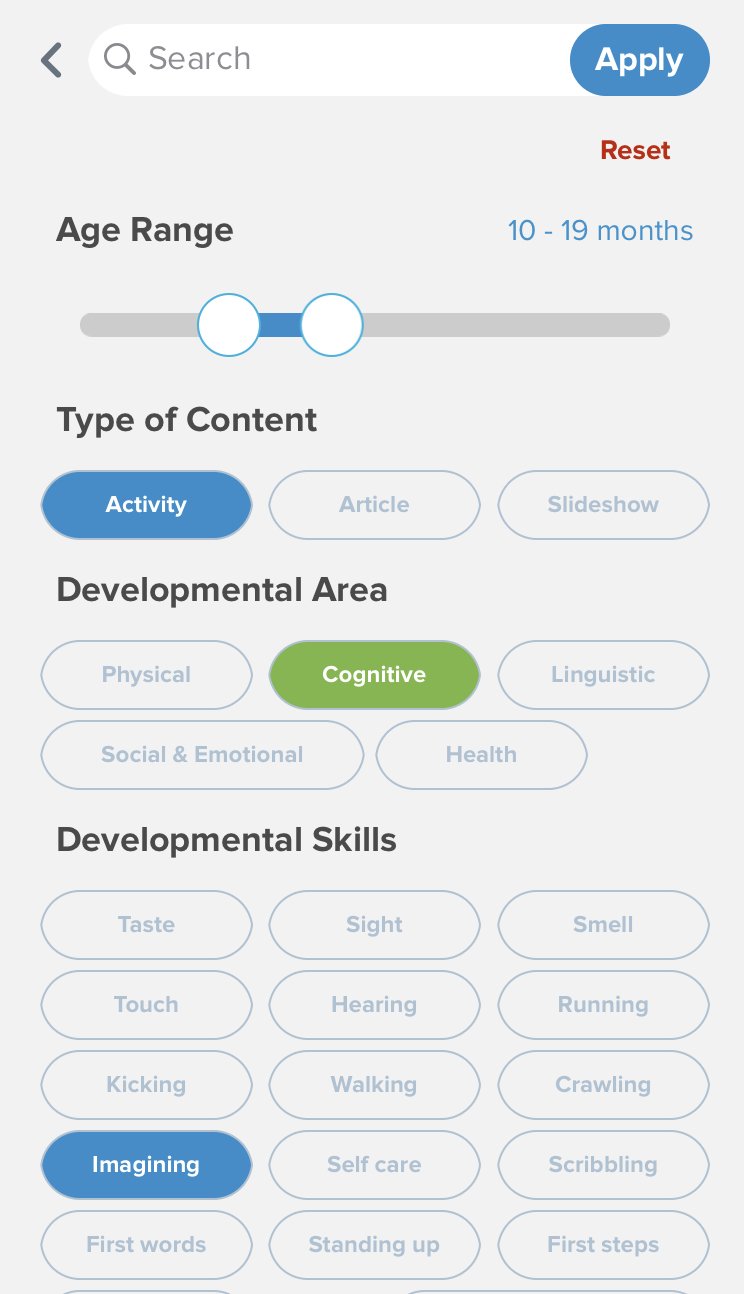
My family
In the “My Family” section you will find your child’s profile, your own profile, and other family members.
If you have more than one child, this is the section where you can choose whose content to see. By clicking on one of your children, the app will show you the content related to that child (including “My School”), which means you’ll only see the plan, school, milestones, and other content related only to the child you selected.
To see another child’s plan, just return to the “My Family” section and click on the child you wish to see.
My children
Next to your child’s profile, you’ll see two buttons: one to edit their profile, and a second one to add reminders to do activities with them.
To edit the profile, click on the crayon next to their name. To add a reminder, click on the bell.
Changing the profile picture
To change your child’s profile picture, just head to their profile, click on the crayon to edit, and click on the current image. Then, select if you want to take a new picture or choose one from your gallery. Finally, click on “Save profile” to save the changes.
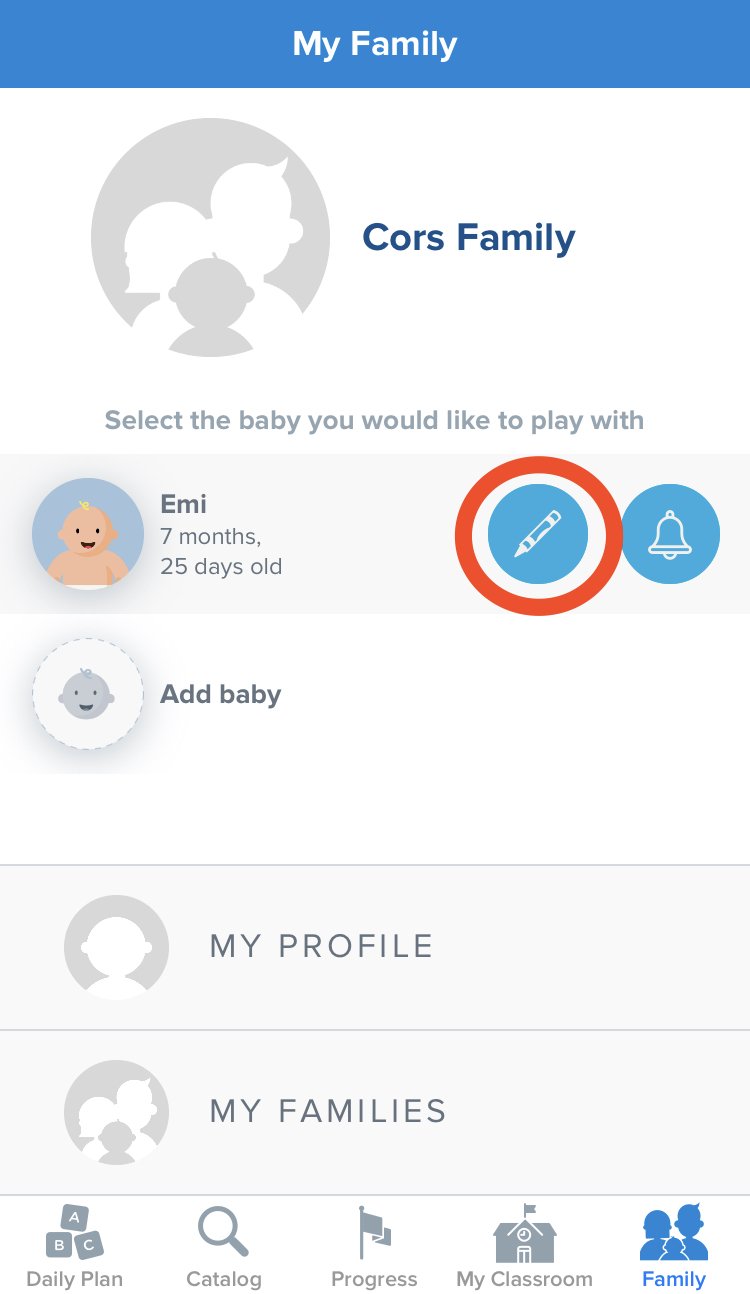


My profile
Just like your child, you have your own profile. To access it just click on “My Profile”.
In this section, you can change your profile picture, choose what type of notifications you want to receive, manage your subscription, and change the settings on your account.
Signing out
To sign out of your profile in the Kinedu app, go to the bottom of your profile page and click “Sign out”.
Family members
Kinedu gives you the option of adding family members and other people who take part in your child’s care and upbringing.
In the “Family members” section within “My Family”, you can see the different members of your family and consult their activities. Just click on any member and you’ll be able to see the activity and interactions they’ve had with your child.
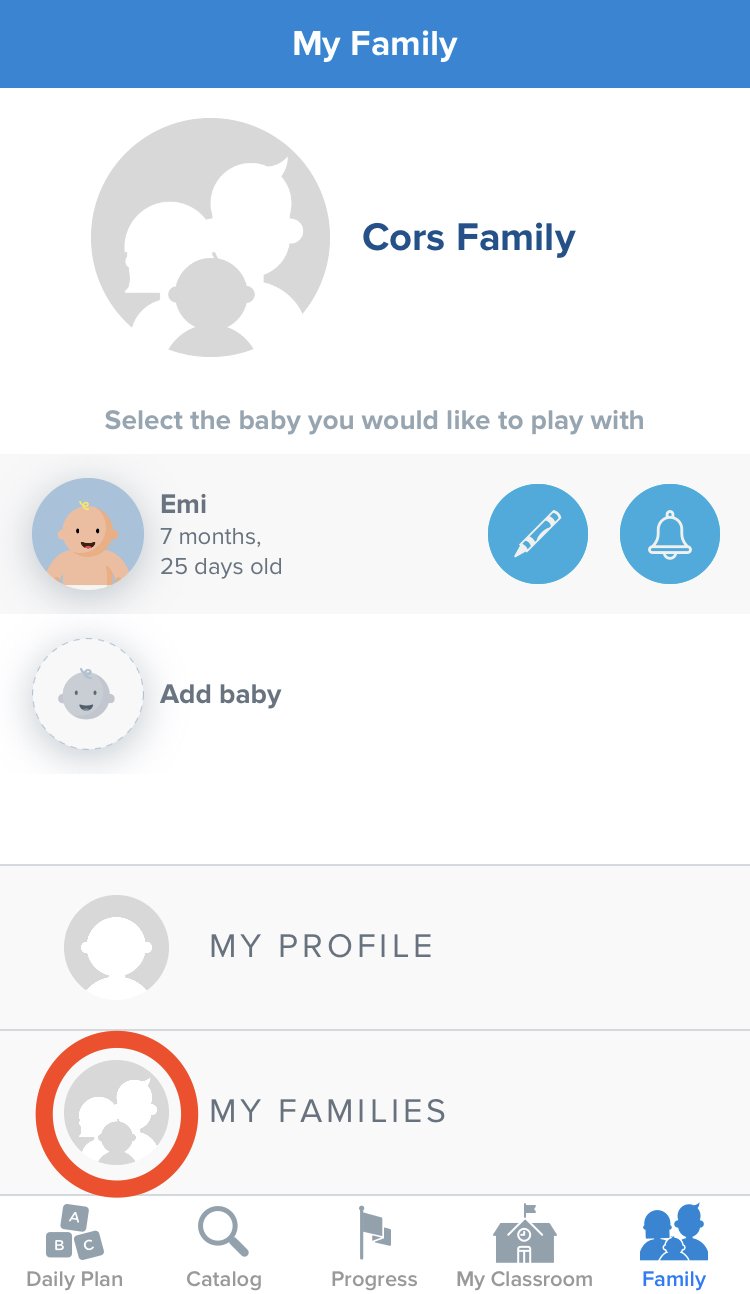
In this section, you can also add new family members, manage their accounts, and delete members.
Adding family members
To add a new family member, you just need their email address. Click on the “Family members” section within “My Family”, go to the bottom of the page, and click on “Add member”.
On the new page, enter the email address of the person you want to add, the role they have (mother, father, grandparent, nanny, etc), and the type of user they’ll be.
There are two different types of users, and they have different permits on the Kinedu app: main caretaker and caretaker.
- Caretaker: They can see the weekly plan and activities, consult the catalog, update milestones, and access the “My School” section.
- Main caretaker: They have the same permits as the caretakers, but they can also add new family members, edit the child’s profile, and manage the account.
After filling out the information, just click on “Send invitation”, and we’ll send an email to the new member with the necessary instructions for them to join Kinedu.
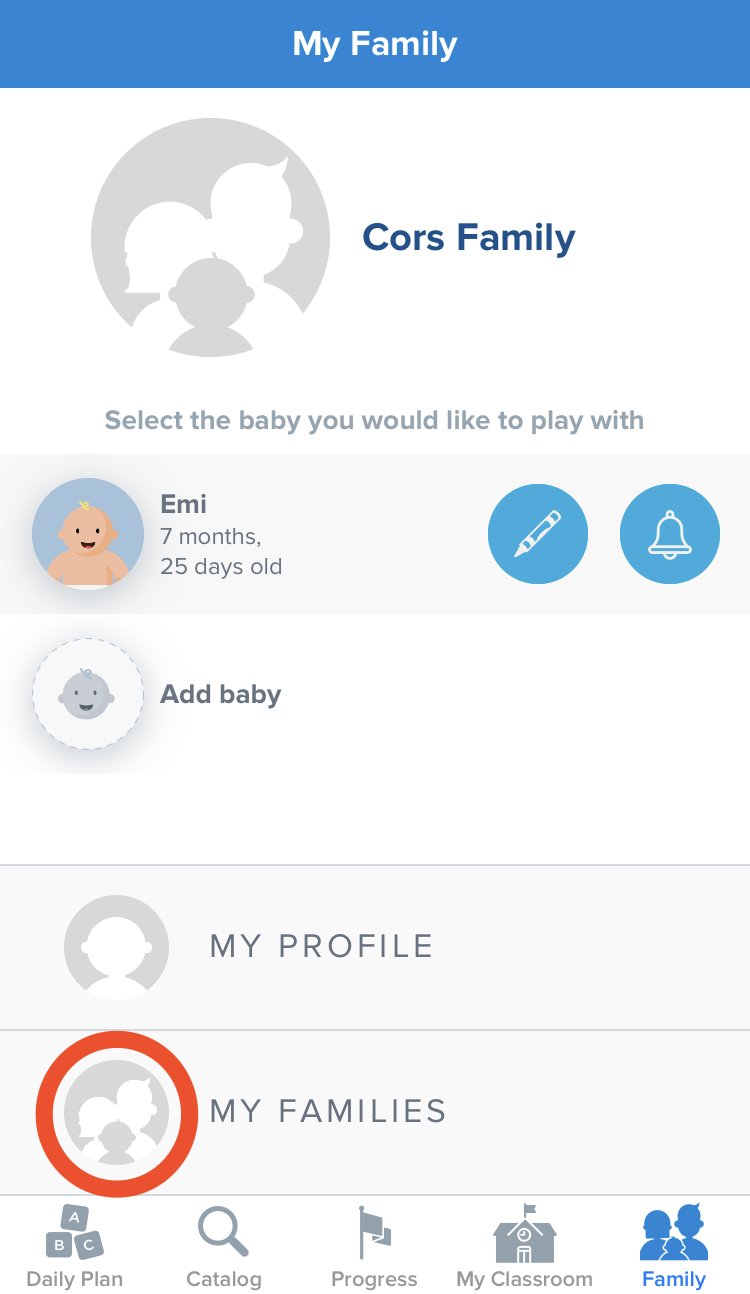
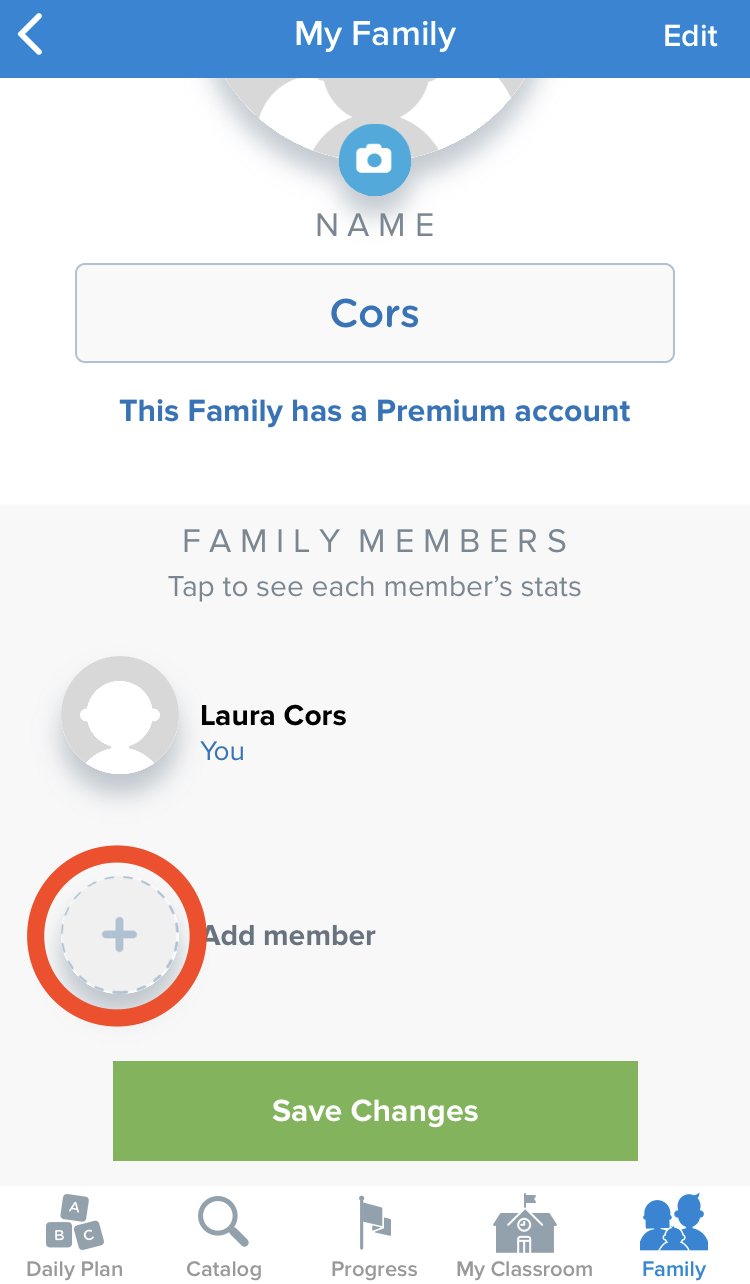
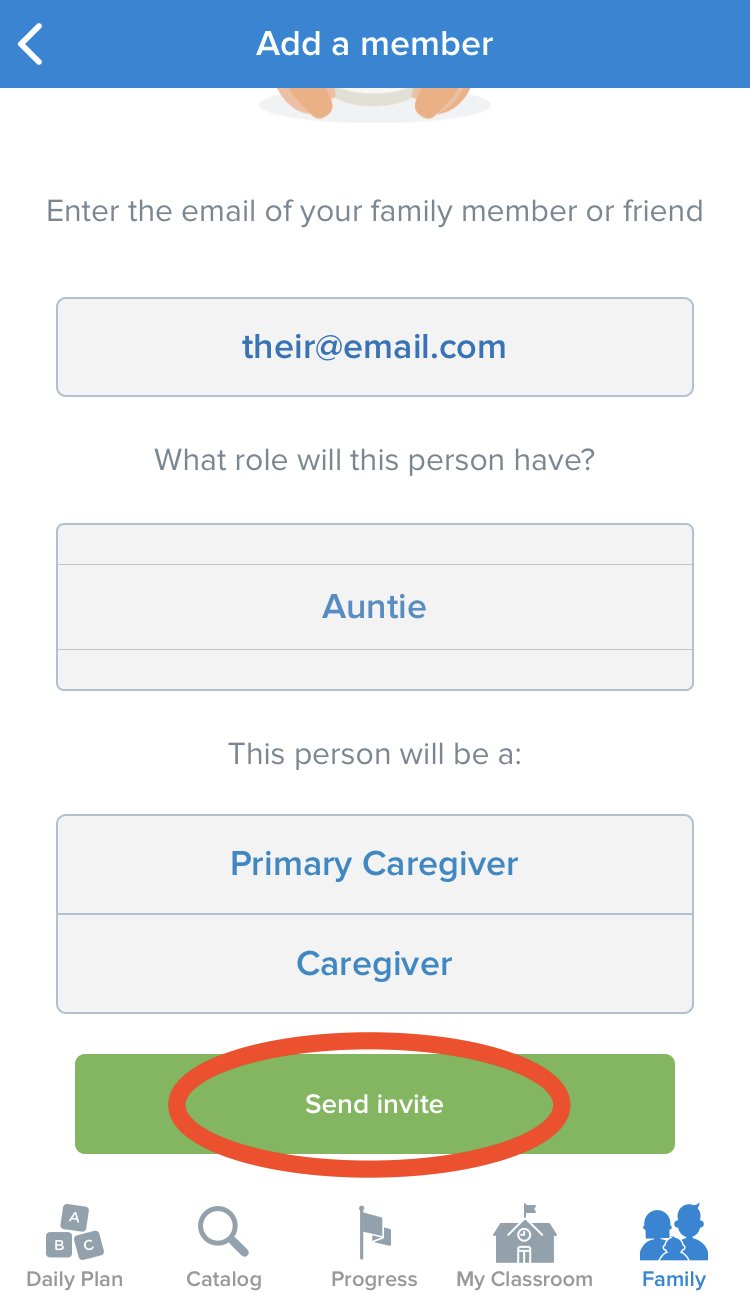
What should I do if my family member doesn’t get the invitation?
If one of your family members can’t see the Kinedu invitation on their Inbox, we suggest checking the Spam folder. In any case, your family members can also receive an invitation through the app, creating an account with the exact same email that the invitation was sent to.
If your family members are already Kinedu users, they need to close and re-open the Kinedu app to load the pending invitation. Once the invitation is accepted, they can choose their new family as predetermined.
Deleting family members
To delete a family member, go to the “My Family” section, click on “Family members”, and select the “Edit” option on the upper right corner.
Afterward, click on the red delete button next to the member and confirm by clicking the “Delete” message that will appear.

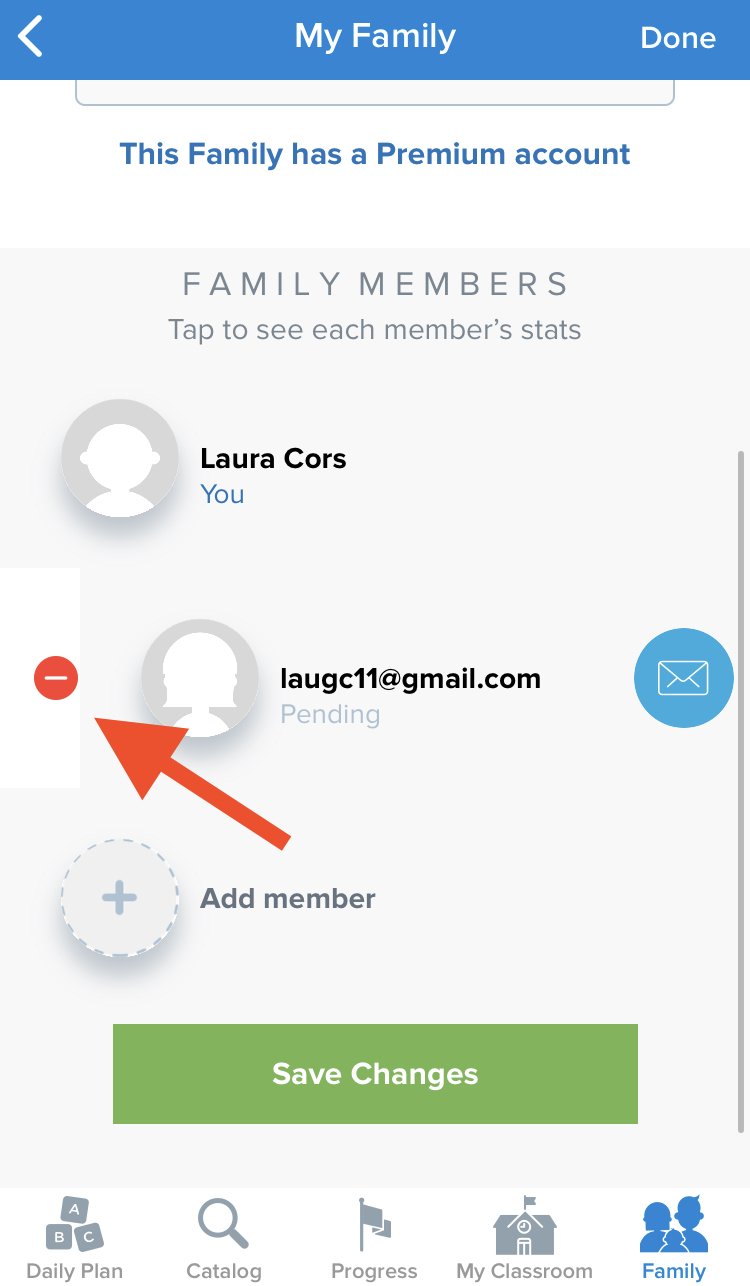
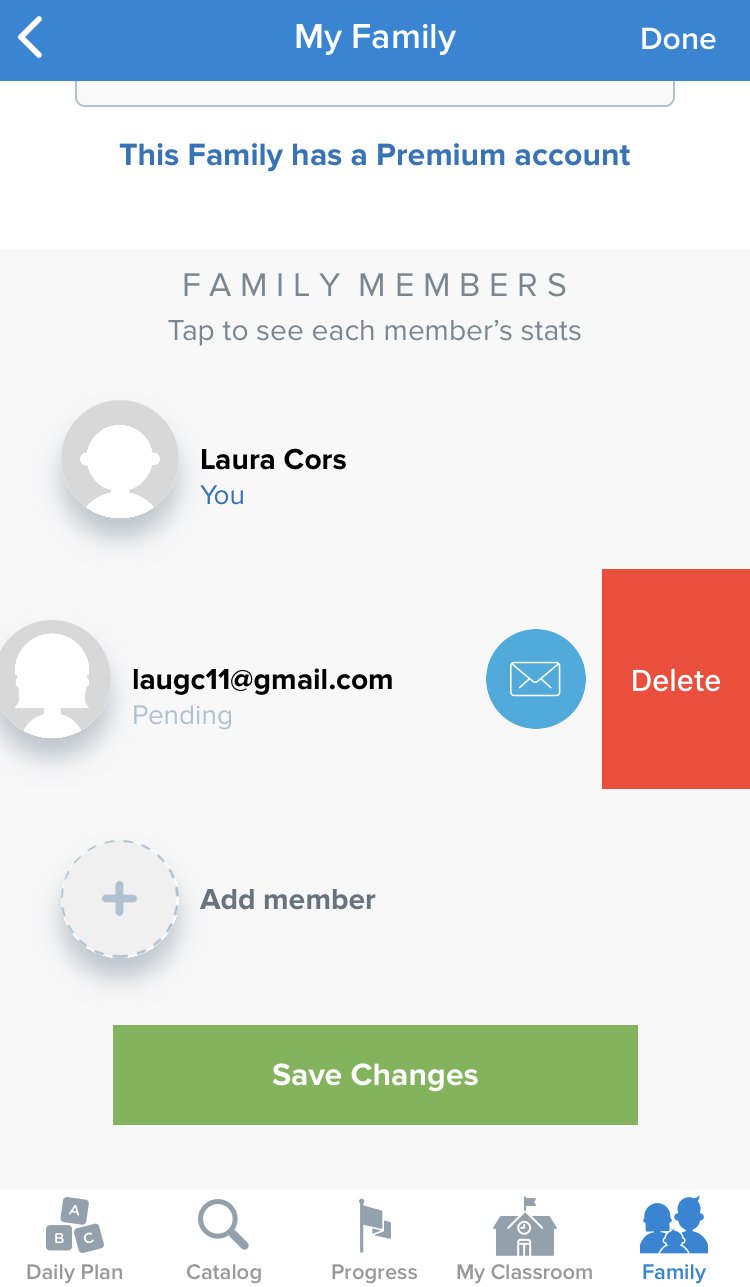

Asking for help
If you can’t find the answers to your questions on this guide, write to us at hello.classrooms@kinedu.com. We’ll be glad to help!
If you have any specific doubts or questions about your child’s development, write to us or contact your school.








